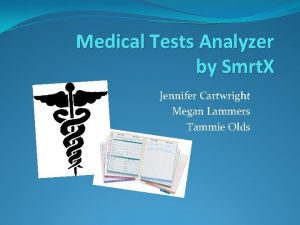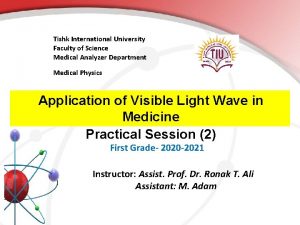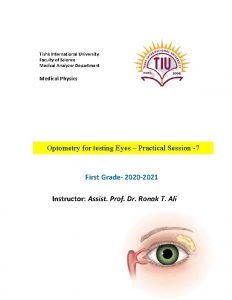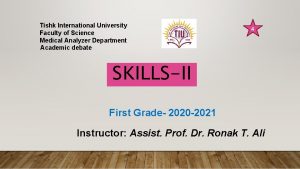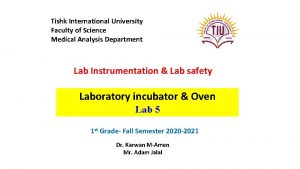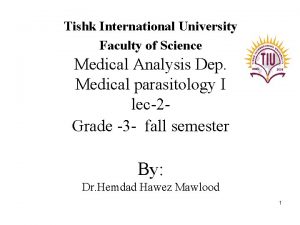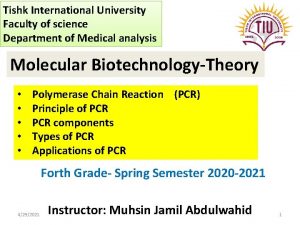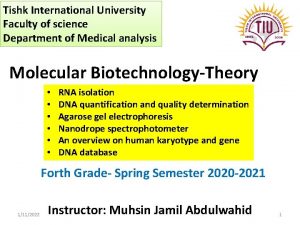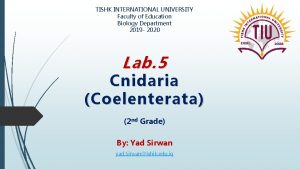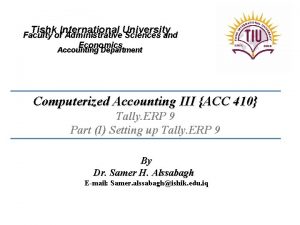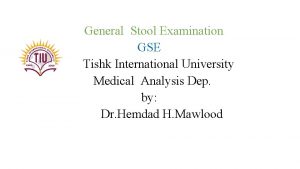Tishk International University Faculty of Science Medical Analyzer





















- Slides: 21

Tishk International University Faculty of Science Medical Analyzer Department Medical Physics The Essentials of Writing a Good Lab Report for Introductory Biophysics Courses First Grade- 2020 -2021 Instructor: Assist. Prof. Dr. Ronak T. Ali

What we will cover tonight • • • The experiment Parts of a report Where to start? Breakdown of content Major issues in content (must do’s) Common errors that hurt your grade

Improving your lab report: Improvements from first submission/draft to final product

The Experiment • Be Prepared! (i. e. Reread the lab before starting to write!) – – – Big Picture: What’s the point? Make yourself a flowchart: They really do help Reread the lab questions embedded in the lab manual. Keep the focus on the big picture… Ex. What was the lab all about? Determining the effects of temperature on growth rate of stonefly larvae…. t was not about measuring turning on the balance, labelling the tubes, etc.

WHAT IS A LAB REPORT? a complete and detailed record of an experiment. The information provided in a lab report should be specific enough that the reader would be able to replicate the experiment. https: //academichelp. net/wp-content/uploads/2013/01/lab-rep �What is a lab report?

STRUCTURE: PARTS OF THE LAB REPORT � Cover Page: Title and Author(s) � Introduction � Statement of Objective � Materials and Methods � Results � Discussion � References � Appendices (not always needed)

COVER PAGE: TITLE AND AUTHOR(S) � Center the title on the page about 2 inches from the top of the page. � Center the student’s name, class, and date completed below the title. � Type the student’s last name and page number in header, flush with right margin.

INTRODUCTION What it contains: What it does not contain: � Context of study � Results � Pertinent background � Conclusions about the study information � Written in Past Passive tense � Should be one to two paragraphs long depending upon the experiment conducted � Non-relevant information

The Introduction • What is our big question? • Why are we asking it? • How will we answer our question? What particular methods are we using to get at this question? Why these methods…what do they show? • What do we expect? PREDICTIONS • Why do we expect this? HYPOTHESES

STATEMENT OF OBJECTIVE � Objective of the experiment � Answers two questions: � Why is this experiment being performed? � What information can I learn? � Hypothesis � The student’s educated prediction about the outcome of the experiment � Must be clearly stated and specific � It’s okay for your hypothesis to be wrong!

MATERIALS AND METHODS � Contains materials and equipment used along with any explanation(s) of equipment, if necessary. � Contains the step-by-step process followed to conduct the experiment. � Written in paragraph form, NOT a bulleted list. � Always written in third person (do not use “I”). � Be as detailed as possible. � The purpose of this section is to allow another person to follow the instructions and replicate the experiment.

What’s the biggest problem that we see as TAs grading these lab reports…. . ? Let’s just say… “Level of Detail” is an art in itself….

Consider these two paragraphs… On January 5, I obtained four paper cups, 400 g of potting soil, and 12 radish seeds. I labeled the cups A, B, C, and D and planted three seeds per cup, using a plastic spoon to cover each seed with about one-quarter inch of soil. On January 5, I planted three radish seeds in each of four individually marked paper cups, covering the seeds with about one-quarter inch of potting soil. Pechenik, 1997 I know which I would rather read…why?

RESUL TS Sales � Summarize the results in paragraph form. � Create tables or charts of the data collected, if applicable. � If using tables or charts be sure to label them clearly. � DO NOT interpret the data. This section should only contain the raw facts. 1 st Qtr 2 nd Qtr 3 rd Qtr 4 th Qtr Chart Title 6 5 4 3 2 1 0 Category 1 Category 2 Category 3 Category 4 Series 1 Series 2 Series 3

Figures…Tables and Graphs • Focus: What is the best way to show the trend in my data? • Axes : clear, concise labels, avoid excess words • Axes labels MUST have units • Legend: Not a repeat of both labels • Tick mark labels • Spread it out! • Info per unit is horizontal in a graph • If you can’t read it, neither can I.

Titles for Figures • Number & Title are necessary! For example: Figure 1: Mean number of nodules produced in each of three treatments: low light, moderate light and high light conditions

Axes labels: • • • for example…. Time (min) p. H Blood glucose (mg/ml) Temperature (°C) Product (mg) Absorbance (400 nm)

DISCUSSION � Interpretation of data collected � Did the experiment prove or disprove the hypothe � If hypothesis was wrong, why and how was it wron � Did any errors occur during the procedure? � How might these errors be avoided in the future? � Discussion of the implication of results sis ? g?

• What did you expect to find (predictions/hypotheses) and why? • How do your results compare to what you expected? • How might you explain any unexpected results? • How could you test your explanation for this? • How could you improve this experiment if you were to repeat it? • Citations are a must! As is a good set of background information. (Lombard and Terry, 2004)

REFERENCES � See your professor to determine if outside sources are necessary and what format to cite them in. � Your lab manual counts as a source. � All sources used should be recorded on a separate page at the end of the report. � This page is titled either References (APA) or Works Cited (MLA). � References should be organized alphabetically by authors’ last names. Need citation help? See a Writing Center Coach or check out the SSTC’s Online Resource Cente

THINGS TO KEEP IN MIND! � Remember to keep your writing in Past Passive tense. � Everything is presented as if by a passive-third party observer. � Ex. You would not say “Timmy ate the bagel. ” Rather, you would say “The bagel was eaten. ” � There is an example of a lab report in your lab manual. You can always refer to that if necessary. � Have a question? Remember you can always check with your professor! � Do you need to have an Abstract? � Do you need to have Appendices?
 Masaryk university medical faculty
Masaryk university medical faculty Chronic meningitis
Chronic meningitis University of bridgeport engineering
University of bridgeport engineering University of bridgeport computer engineering
University of bridgeport computer engineering Fsu cs faculty
Fsu cs faculty Brown university computer science faculty
Brown university computer science faculty Medical test analyzer software
Medical test analyzer software Medical faculty in novi sad dean
Medical faculty in novi sad dean Talk about your favorite subject
Talk about your favorite subject University of split faculty of maritime studies
University of split faculty of maritime studies Hubert kairuki memorial university faculty of medicine
Hubert kairuki memorial university faculty of medicine Semmelweis university faculty of medicine
Semmelweis university faculty of medicine King abdulaziz university faculty of medicine
King abdulaziz university faculty of medicine Faculty of business and economics mendel university in brno
Faculty of business and economics mendel university in brno Singularity university faculty
Singularity university faculty Territorial matrix vs interterritorial matrix
Territorial matrix vs interterritorial matrix Faculty of engineering university of porto
Faculty of engineering university of porto Charles university faculty of humanities
Charles university faculty of humanities Faculty of veterinary medicine cairo university logo
Faculty of veterinary medicine cairo university logo Faculty of law of the university of zagreb
Faculty of law of the university of zagreb University of montenegro faculty of law
University of montenegro faculty of law University of kragujevac faculty of technical sciences
University of kragujevac faculty of technical sciences






